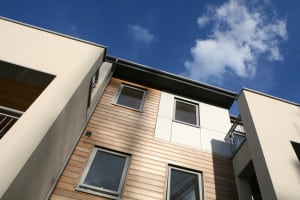Red Cedar is now being favoured by architects more and more as a construction material. It is well known today that timber products, whether natural or of the engineered variety have benefitted from modern technology in material manufacturing, treating and finishing to provide a natural material that will give many decades of good service in the same way as other materials.
The use of cladding panels in construction is well established now, but how do panels having an external skin of red cedar perform and where could they be used?
Why Choose Red Cedar Panels?
Residential apartment blocks are one area where Red Cedar Panels are being used more and more. There are many riverside developments around the UK where modern apartment buildings have been constructed and here, many will have red cedar panelling as part of their external elevations.
The use of powder coated aluminium windows, doors and curtain walling is widespread in modern buildings but architects are favouring the use of red cedar panels to provide a natural complement to the modern aluminium glazing systems.
Bearing in mind that some apartment blocks can span several floors, the panelling is also being used at high level where it is more likely to be exposed to the elements. Despite this, it remains durable, weather resistant, will resist decay and is long lasting.
Red Cedar remains one of those natural materials that delivers outstanding long term performance. The red cedar material used to manufacture insulated panels and cladding panels is available in a wide range of thicknesses as well as differing pattern and panel widths.
Depending upon how Red Cedar is exposed to the elements and how it is dried is what produces different tones in colour. The drying process of red cedar and what elements it is exposed to will result in different colours being achieved naturally.
Red Cedar is a renewable resource.
The red cedar material used to construct cladding panels comes from the managed forests of Canada. Legally harvested and properly managed, the forests are sustained and maintained. It is well reported that two or more trees are planted for every tree that is harvested to produce the material for construction. In the material itself are naturally occurring properties that enable the material to self preserve totally naturally.
These natural properties in the structure of red cedar can also mean every panel can have it’s own unique colour.
Only about 1% of standing timber is actually harvested each year and with red cedar being highly biodegradable means little environmental impact owing to it requiring far less energy than other materials to product.
Other Advantages of red cedar panels
The natural properties of red cedar are such that they are hard to replicate by modern materials such as plastic, metal or products of a composite nature. Other naturally occurring properties are grains, textures and hues.
Any construction material will require some form of maintenance but when correctly finished it can guarantee years of trouble free service.
The natural properties of red cedar give excellent expansion and material stability coupled with low shrinkage in changing weather and environmental conditions. It is also resistant to warping and twisting and offers some of the best thermal insulation of typical softwood materials and especially when compared to other construction materials such as metal, cement fibres or brickwork.
